In the grand architecture of human health, teeth are more than functional tools for chewing—they are gatekeepers of nutrition, protectors of bone structure, and silent participants in our psychological and social well-being. When natural teeth are lost, the void is rarely confined to the mouth. It ripples outward: digestion is compromised, confidence erodes, and even facial structure begins to collapse. Against this backdrop, dental implants emerge not simply as a cosmetic solution, but as a profound intervention in health and longevity. The question is not whether they create beautiful smiles, but whether they truly extend quality of life—and if they are indeed a worth investment for the long run.
The Biology of Replacement: Why Implants Are Different
Unlike dentures or bridges, dental implants interact with the body on a cellular level. The process of osseointegration, where titanium or zirconia fuses with jawbone, transforms implants from passive objects into living anchors. This fusion prevents the gradual bone resorption that often follows tooth loss. Without this stimulation, the jaw can lose up to 25% of its volume within the first year of tooth loss, reshaping the face and weakening the oral foundation.
By maintaining bone density, implants safeguard more than teeth. They preserve the architecture of the face, protect neighboring teeth from drifting, and stabilize the very framework that allows us to chew, speak, and age with dignity. In this sense, dental implants are not just replacements—they are reinforcements for the body’s structural longevity.
Nutrition, Digestion, and the Longevity Connection
The ability to chew efficiently is not a trivial matter. Poor dentition often forces people into softer, carbohydrate-heavy diets, reducing intake of fibrous vegetables, lean proteins, and other foods essential for long-term health. Malnutrition in older adults is closely linked to frailty, cognitive decline, and diminished life expectancy.
Here, dental implants play an unseen but pivotal role. By restoring full biting force—often indistinguishable from natural teeth—they enable people to return to diverse, nutrient-rich diets. Scientific studies have shown correlations between implant-supported chewing and improved digestion, better absorption of nutrients, and even enhanced metabolic health. In this light, implants extend beyond aesthetics: they are a nutritional lifeline that underpins vitality and resilience, this is how dental implants improve oral health.
The Psychological Dimension: Confidence as a Health Factor
Longevity is not measured only in years, but in the quality of those years. Social interaction, self-esteem, and emotional health are all tied to oral appearance and function. Missing teeth can diminish confidence, leading to social withdrawal or reduced participation in daily life. Over time, these psychological stresses can exacerbate conditions like depression, which in turn are linked to poorer health outcomes.
Dental implants, by restoring a natural smile, unlock a powerful psychological shift. Patients often report not only improved confidence, but also a renewed willingness to engage socially, pursue professional opportunities, and enjoy public life without embarrassment. This psychological resilience is a key but often overlooked dimension of human longevity.
Comparing Options: Why Implants Are a Worth Investment
Dentures and bridges, while less costly upfront, come with limitations. Dentures can slip, impair speech, and cause gum irritation. Bridges require the grinding down of healthy adjacent teeth, compromising long-term oral health. Both solutions fail to address bone loss, leading to inevitable structural decline.
In contrast, dental implants stand out for their durability and functionality. With proper care, they can last decades—often a lifetime—whereas dentures and bridges may require frequent replacement. Over the span of years, implants prove to be the more economical choice. Their longevity, combined with their biological and psychological benefits, make them a worth investment not just in dentistry, but in overall quality of life.
The Science of Aging Gracefully
Longevity science increasingly emphasizes “healthspan” over “lifespan”—not merely how long we live, but how well we live. Teeth are a crucial piece of this equation. By preventing bone loss, enabling nutrition, and sustaining confidence, implants align with the very pillars of healthy aging.
Even emerging research in gerontology supports the connection: tooth loss has been associated with increased risks of cognitive decline and systemic disease. While dental implants are not a cure-all, they mitigate one of the key biological stressors of aging. In that sense, implants are not simply medical devices—they are part of a holistic strategy for aging with strength, dignity, and vitality.
Innovation and the Future of Implants
The science of implants is evolving rapidly. From nanocoated surfaces that accelerate healing, to digital planning tools that enhance surgical precision, the field is moving toward more predictable, less invasive, and even more lifelike restorations. Future innovations may extend the role of implants further—integrating smart biomaterials that resist bacteria, or even bioengineered roots that merge seamlessly with living tissue.
As technology advances, implants will become more accessible, durable, and biologically harmonious. Their role in promoting long-term health will only deepen, cementing their status as one of modern dentistry’s greatest contributions to human longevity.
Teeth as Investments in Life Quality
When viewed narrowly, dental implants are a solution for missing teeth. But when examined through the lens of science, psychology, and society, they are far more: they are stabilizers of health, guardians of nutrition, and restorers of confidence. They bridge the gap between cosmetic enhancement and genuine medical intervention, influencing not just how long we live, but how well.
In an era where quality of life is as valuable as longevity itself, dental implants prove to be more than an indulgence in appearance. They are, in fact, a worth investment in the future of health, dignity, and human resilience.

